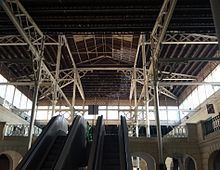Alternative names Covered Market Type Market hall Current tenants Arkadia Ltd Opened 1861 Cost 3,934 GBP Construction started 1859 | Status Intact Location Valletta, Malta Completed 1861 Floors 3 Architectural style Victorian architecture | |
 | ||
Materials Cast iron, Wrought iron, Limestone Similar Church of Our Lady of Pilar - Vall, Casa del Commun Tesoro, Slaves' Prison, Banca Giuratale, Basilica of St Dominic - Valletta | ||
Valletta market
The Valletta Market (Maltese: Is-Suq tal-Belt, [ɪs suːʔ tɐl bɛlt]; meaning "City Market"), also known as the Covered Market, is a 19th-century market hall in Valletta, Malta. It is notable for being the first building in Malta to be constructed mostly of iron. It began to decline in the 1980s, but the building is currently being renovated and there are plans to convert it into a shopping centre.
Contents
History
A 16th century map shows that the site, now occupied by the present marlet was a square named Piazza del malcantone. The site was used as part of the gallows parade of a guilty person, which was humiliated and tortured around Valletta, before being hanged in Floriana. At one point, during the Order of St. John, the first market was built on site. During the early British period, it was found to have several issues and hence was demolished.
Plans to reconstruct a covered market in Valletta began in 1845, and the Valletta Market was built between 1859 and 1861 on the site of the old prisons. The building was designed by the Superintendent of Public Works, Hector Zimelli, but was completed under the direction of Emanuele Luigi Galizia. Construction cost £3934, and the market originally contained 153 stalls and 65 cellars.
The building was bombed on 7 April 1942, during the Second World War, destroying one third of the building. The damaged parts were repaired soon afterwards, but were not rebuilt to the original plan and the roof's symmetry was lost. By 1966, the market no longer met hygiene standards so it was overhauled. In 1970, two new floors were built and a pair of escalators were installed. The market thrived for a few more years, before it began to decline in the mid-1970s.
In 1982, the food market was transferred to Floriana, and a year later the Valletta Market was re-branded as a shopping arcade called Ixtri Malti (Buy Maltese). This move was highly unsuccessful, and the food market moved back to Valletta in 1989. Despite this, the market continued to decline.
The Malta Environment and Planning Authority scheduled the building as a Grade 1 national monument on 28 March 2012.
Plans for the restoration of the Valletta Market began following Valletta's nomination for European Capital of Culture 2018. The government deemed restoration of the structure as part of the Valletta regeneration master plan. The building has been leased to the supermarket chain Arkadia Co. Ltd for 65 years. Restoration is estimated to cost around €7 million, and it is expected to be complete by May 2017. It is planned that 1980s additions to the building be dismantled, while the original elements of the structure are to be preserved. Once restored, it is planned that the stalls within the building be leased to shops or catering establishments, while part of the building is to be used for cultural activities.
The renovation of the Valletta Market began in May 2016 and is currently underway.
Architecture
The Valletta Market has a rectangular plan, and the walls and arches making up its three floors are built of limestone like many other buildings in Malta. However, the roof is made of cast and wrought iron decked in timber, and it is supported on cast iron columns and trusses. This use of iron makes it an unusual structure, and it was the first building in Malta to be constructed mostly of pre-fabricated iron. Iron had been used in earlier structures on the island, such as the Naval Bakery and the Corradino Prisons, but on a much smaller scale than the Valletta Market.
The design of the Valletta Market was inspired by Covent Garden (London) and Halles Centrales (Paris). The design of the Valletta Market influenced similar projects elsewhere in the British Empire, including in Calcutta.
